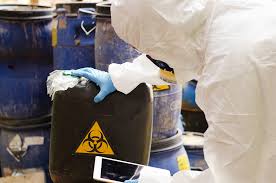Handling hazardous waste is a crucial task in industrial operations and environmental management that calls for careful planning, strict adherence to protocols, and an unwavering commitment to safety. If handled improperly, hazardous waste presents serious risks to the environment, public health, and safety. We’ll go over the fundamental policies and practices for managing hazardous waste safely in this blog, emphasizing the value of readiness, training, and alertness in reducing risks and guaranteeing adherence to legal obligations.
Recognizing Hazardous Waste
Any waste material that, because of its chemical, physical, or biological characteristics, seriously endangers the environment, public health, or safety is considered hazardous waste. Hazardous waste typically consists of flammable liquids, infectious materials, corrosive materials, and toxic chemicals. A variety of sources, such as manufacturing processes, industrial processes, laboratory operations, and healthcare facilities, can produce hazardous waste.
The Value of Safety Procedures
Strict adherence to safety guidelines and procedures is necessary when handling hazardous waste in order to reduce risks and avoid mishaps. When handling hazardous waste, adherence to the following procedures is crucial for maintaining safety:
1. Risk Assessment: To identify potential risks related to the handling, storage, and disposal of hazardous waste, conduct a thorough risk assessment. To identify the best control and protective measures, consider the waste’s physical, chemical, and biological characteristics as well as possible exposure routes and health effects.
2. Training and Education: Give workers handling hazardous waste thorough training and instruction. Make sure that employees are aware of the risks connected to various waste kinds, are proficient in the proper usage of personal protective equipment (PPE), and are knowledgeable about emergency protocols in the event of spills or accidents.
3. Personal Protective Equipment (PPE): Provide workers with the proper personal protective equipment (PPE) to guard against exposure to hazardous waste. This could involve coveralls, gloves, safety glasses, respirators, and boots resistant to chemicals. When handling hazardous waste, make sure personal protective equipment is appropriately fitted, maintained, and worn.
4. Engineering Controls: To reduce exposure to hazardous waste and stop releases into the environment, use engineering controls such as ventilation systems, containment devices, and spill containment barriers. Work spaces and storage facilities should be designed to reduce the possibility of spills, leaks, and mishaps.
5. Safe Handling Protocols: Create and put into effect safe handling protocols for various categories of hazardous waste. This could involve guidelines for handling, labeling, moving, and storing waste products as well as protocols for cleaning up spills and releases and decontaminating areas.
6. Emergency Response Planning: Create and maintain emergency response protocols and plans on a regular basis to address incidents involving hazardous waste. Make certain that staff members have access to emergency response tools and resources, are trained in emergency response procedures, and know how to report incidents.
7. Regulatory Compliance: Become acquainted with the applicable national, state, and local laws, rules, and guidelines pertaining to the management of hazardous waste. To avoid fines, penalties, and legal ramifications for non-compliance, make sure your facility complies with waste characterization standards, reporting requirements, and permit requirements.
The Best Methods for Managing Hazardous Waste
Using best practices for handling hazardous waste can improve safety and lower risks even more than adhering to safety protocols. Among the finest practices are:
1. Waste Minimization: Reduce the amount of hazardous waste produced by substituting materials, streamlining processes, and reducing sources. Reducing waste generation and minimizing environmental impacts can be achieved by putting lean manufacturing principles, recycling programs, and pollution prevention measures into practice.
2. Labeling and Segregation: To avoid spills, accidents, and reactions, separate hazardous waste from non-hazardous waste and incompatible materials. Hazard statements, chemical names, and the proper hazard symbols should be written on hazardous waste containers to alert workers and emergency personnel to potential dangers.
3. Appropriate Storage: Keep hazardous materials in spaces designated for that purpose, which should have sufficient ventilation, secondary containment systems, and spill containment techniques. In order to avoid cross-contamination and unintentional releases, make sure that waste containers are securely sealed, appropriately labeled, and kept apart from incompatible materials.
4. Frequent Maintenance and Inspections: To find potential risks, leaks, or flaws, regularly inspect equipment, containment systems, and storage areas for hazardous waste. As necessary, carry out routine maintenance, upgrades, and repairs to guarantee the integrity and security of the waste handling infrastructure.
5. Engagement of Employees: Promote employee involvement and participation in hazardous waste management programs. Give employees the chance to offer feedback, ideas, and training so they can take responsibility for safety and participate in initiatives for ongoing improvement.
6. Documentation and Record-Keeping: Keep thorough records of all activities related to the creation, processing, and disposal of hazardous waste. Maintain records of waste manifests, shipping information, regulatory permits, and training credentials to prove legal compliance and make reporting and auditing easier.
Seeking professional hazardous waste disposal companies‘ help can ensure proper handling, transportation, and disposal of hazardous waste, mitigating risks and ensuring compliance with regulations.
In Summary
When it comes to managing hazardous waste, safety is crucial. Businesses and organizations can reduce risks, safeguard employees and the environment, and guarantee regulatory compliance by putting strict safety protocols into place, offering thorough training, and encouraging a culture of safety awareness. We can lessen the risks connected to industrial operations and work toward a safer, healthier, and more sustainable future for all by putting safety first when handling hazardous waste. Learn more about Waste Disposal Group for expert guidance and comprehensive solutions tailored to ensuring the utmost safety and regulatory compliance in hazardous waste management processes.

